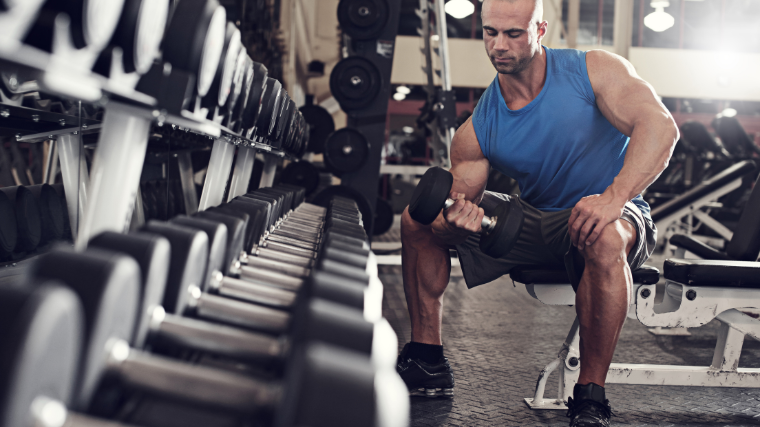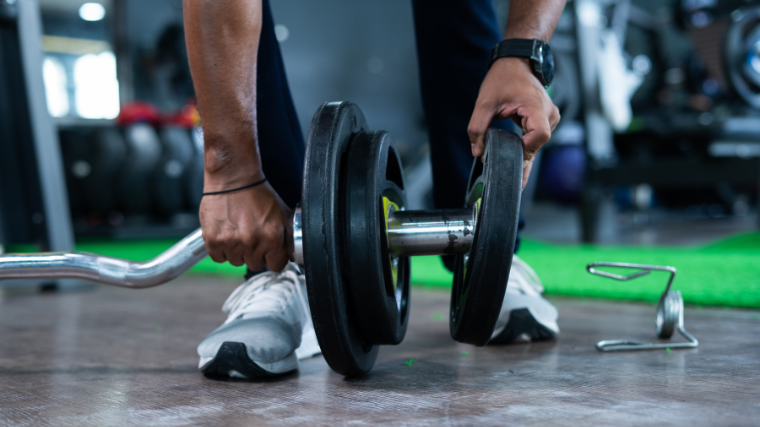Getting strong isn’t all sunshine and rainbows. A 500-pound deadlift might sound like an alluring goal, but if you want to pull five plates and more, you have to, literally, get yourself there in the first place.
No one walks into the weight room and loads their max up onto an empty barbell. Ramp-up sets are the work between the work; everything you do on your way to the weights you’re meant to lift.

If you’re a strength competitor or hobbyist, how you approach ramping up to your working sets can make or break your performance once you get there. There’s some surprising science behind building up to big lifts — here’s the breakdown.
Guide to Ramp-Up Sets
- What Are Ramp-Up Sets?
- Benefits of Ramp-Up Sets
- Bodybuilding Ramp-Up Sets
- Powerlifting Ramp-Up Sets
- Weightlifting Ramp-Up Sets
What Are Ramp-Up Sets?
Ramp-up, or ramping sets, are the necessary stepping stones between your first warm-up set and your “working,” or prescribed, sets in a given exercise.
If you lift heavy in the gym — whether as part of strength-sport-specific training or just because you like it — you probably don’t march over to the squat rack and slide three plates on the bar. You have to ramp up to that level of intensity.
According to strength coach and nationally-ranked weightlifter Zack Telander, the main goals of ramp-up sets are to:
- Warm-up your technique
- Raise core temperature
- Prepare your nervous system for heavy lifting
Telander remarks that the driving principle behind ramp-up protocols is to gradually increase weight while you decrease the number of repetitions you perform. Ramping sets can vary tremendously depending on the type of strength training you practice or how heavy your working sets are.
What the Science Says
Unfortunately, research on ramping sets and their potential impact on top-level performance is sparse. For many athletes, the process of approaching their working sets is a personal endeavor that comes largely from experience and experimentation.
However, the scientific community has long examined the efficacy of specific warm-ups, defined as preparatory activities performed for the purpose of improving one clearly-defined goal, rather than physical activity in general.
Certain research has indicated that — no matter what you’re warming up for, be it a max-effort lift or an explosive sprint — it’s perfectly possible to “overshoot” your warm-up and negatively impact your performance as a result. (1)

Some more targeted studies have looked at how inexperienced athletes approached a 1-rep maximum test on a compound exercise like the bench press. There’s some evidence that the optimal amount of ramp-up sets lies somewhere between three and five.
That said, data on the subject is far from conclusive and, most importantly, research is often conducted on inexperienced lifters which can vastly skew the results away from practical relevance. (2)
So, in clinical settings, there’s a limited but compelling body of evidence backing the idea that you should actively plan your ramping sets, since it can be quite easy to overdo it to the detriment of maximal strength.
Do Ramp-Up Sets Build Muscle or Strength?
Not all sets are created equal in the arena of resistance training. While anything you do with a barbell is likely a good thing from a health or physical activity standpoint, ramp-up sets aren’t generally considered “productive” for gaining strength or mass.
Research indicates that training below a certain level of intensity — typically around 60 percent of your max — isn’t stimulating enough to encourage hypertrophic or strength-based adaptations. (3)(4)

This is especially true if you’re an experienced athlete with years’ worth of workouts under your belt, but it may not be the case for brand-new gymgoers who are very sensitive to stimuli.
So, while ramping allows you to refine your technique or get engaged mentally, you should still keep it relatively brief so as to not waste energy or time on work that probably won’t further your progress.
Benefits of Ramp-Up Sets
Other than getting you where you need to go safely, properly ramping can benefit your overall weight room performance in a variety of ways. Ramp-up sets aren’t anywhere as productive as the actual work, but they do serve their own purpose.
More Technique Practice
Properly ramping up might entail performing more overall reps per workout than you’re used to — especially if you like to jump into your workouts guns blazing.
However, all those extra reps also amount to more time spent practicing your technique. While a few extra light sets may not feel like time well spent on a session-to-session basis, it can amount to hundreds of reps worth of “free” practice at the end of a training cycle.
This can be especially valuable if you’re working with intricate movements like the snatch or sumo deadlift.
Lets You Test and Refine Cues
Many strength athletes find cueing integral to their performance. The right cue can change everything, but it may not be wise to live-test a new cue with a heavy weight.
Ramp-up sets are the perfect time to implement a new external or internal cue to see how you respond to it. The weights are light enough that you won’t risk taking a tumble if you’re thrown off your game.
A max-effort set is hardly the time to change how you perform with the bar in your hands. Ramping sets make for the perfect testing environment for new postural or effort-based cues.
Provides Feedback About How You’re Feeling
You can also use your ramping sets as a sort of “soft” Rate of Perceived Exertion, or RPE; a means of assessing your potential in real time and getting reliable feedback.
For instance, your last warm-up set of squats might be around 70 to 75 percent of your 1-rep max. If you’ve been training for a while, you probably have a decent barometer of how that weight should feel.

But if you hit your last ramping set and notice the same weight that you usually blast through is sluggish or unstable, it might serve as an indicator that you should take it easy during your workout.
Fatigue doesn’t always present itself in your performance at the beginning of the workout. Properly-calibrated ramp-up sets can sound the alarm for you before you put yourself at risk under a heavy bar.
How to Use Ramp-Up Sets for Bodybuilding
A bodybuilder or physique-minded gymgoer may not need as precise ramping as a strength athlete who has very specific loading parameters. Regardless, if you lift heavy to build muscle, you’ll probably still want to work your way up, especially on compound lifts.
To ramp up properly during a bodybuilding workout, perform 1-2 sets prior to your first exercise of the workout.

Since most bodybuilding workouts involve training the same muscle back-to-back, you probably won’t need to ramp up thoroughly for three different rows on back day. Here’s how it might look in practice if your first exercise is the barbell row and you’re working with 185 pounds:
- Set 1: 95 pounds for 10 reps
- Set 2: 145 pounds for 5 reps
- Set 3 (Working Set): 185 pounds for six to eight reps
Two warm-up sets should be enough to get some blood pumping to your lats and prepare you to lift heavier, but the weight and reps are low enough to not create any kind of meaningful fatigue.
How to Use Ramp-Up Sets for Powerlifting
Ramp-up sets in powerlifting are as much about readying your mind as they are about preparing your body. Moreover, the stronger you get, the more time you’ll need to dedicate to getting to your working sets in the first place.
Someone who benches 190 pounds won’t need nearly as many ramp-up sets as an athlete who benches 450. Your ramp-up sets for the squat, bench press, or deadlift should get you pretty close to your working weights with as little volume accumulated as possible.

They should also be specific to the rep range of your working sets — if you’re squatting sets of three, you shouldn’t necessarily ramp up with sets of six, since strength is a task-specific skill.
Here’s what a ramp-up protocol might look like for an athlete who has to perform sets of five reps in the back squat at 315 pounds:
- Set 1: empty bar for 5 reps
- Set 2: 135 pounds for 5 reps
- Set 3: 225 pounds for 3 reps
- Set 4: 265 pounds for 2 reps
- Set 5: 295 pounds for 1 rep
- Set 6 (Working Set): 315 pounds for 5 reps
This prescription will vary tremendously from athlete to athlete, but the general principles are the same. As a powerlifter, you need to get 100-percent prepared for your working sets while also keeping yourself as “fresh” as possible.
Don’t spend a third of your energy getting to the work that matters in the first place.
How to Use Ramp-Up Sets for Weightlifting
Olympic lifting aligns with many of the same principles as powerlifting. When it comes to ramping up to a heavy snatch or clean & jerk, the goal is the same — get to the “real” lifting with as much energy to spare as possible.
However, the technical intricacy of the weightlifting movements can throw a wrench into the mix. Telander notes that ramping up to a heavy snatch can take between five and 10 attempts, since you may need to address several different technical beats along the way.
The ramp-up protocol for an intermediate weightlifter who has to snatch 120 kilograms (264.5 pounds) for a “heavy double” might look like:
- Muscle Snatch + Overhead Squat (1+2): empty bar for 3 reps
- Snatch Pull + Snatch (1+1): 40 kilograms for 3 reps
- Snatch Pull + Snatch (1+1): 60 kilograms for 1 rep
- Power Snatch + Snatch (1+1): 80 kilograms for 1 rep
- Power Snatch + Snatch (1+1): 90 kilograms for 1 rep
- Snatch: 105 kilograms for 1 rep
- Snatch: 112 kilograms for 1 rep
- Snatch: 116 kilograms for 1 rep
- Snatch (Working Set): 120 kilograms for 2 reps
Weightlifters will commonly use short barbell complexes to “iron out the wrinkles” of their technique as they ramp up.
The general idea of reducing work as you add weight holds true, but it’s often wise to perform partial movements in a sequence to hammer down your pulling posture, turnover time, or lockout speed overhead.
Your Takeaways
Once you reach a certain threshold of strength, you need to start paying attention to how you get from the empty barbell to your actual working sets. Ramp-up, or ramping sets, count as everything between the bar itself and the weight you’re tasked with lifting.
- The goal of ramp-up sets is to get you as prepared as possible while conserving as much energy and time as you can.
- Ramp-up protocols almost always entail reducing the number of reps-per-set you perform while you increase weight.
- The number of ramp-up sets you’ll need depends primarily on how strong you are. The heavier your working sets, the longer a ramp you’ll need to get there.
- Bodybuilders can often get away with just a few ramping sets as long as they focus on a strong mind-muscle connection.
- Powerlifters should ramp up as efficiently as possible to their target load.
- Weightlifters often use complexes to address specific technical elements of the snatch and clean & jerk.
Ramp-up sets are also an opportunity to screen yourself for mobility issues or test out a new cue. They’re a chance to get yourself in the zone — not a chore to bang out as fast as possible on your way to the “real” workout.
All Aboard the Gain Train
Getting stronger is both a blessing and a curse. On one hand, you’re stronger! On the other hand, you’re stronger — which usually means more time spent warming up, loading plates, and getting to the phase of your workout that actually produces results.
Still, that’s far from a good enough reason to not pursue strength altogether. You just have to head to the gym with the right plan in your pocket. Ramp up properly and you’ll find yourself a sharper, smoother, and more successful athlete — without spending all day in the weight room.
References
1. Fradkin, A. J., Zazryn, T. R., & Smoliga, J. M. (2010). Effects of warming-up on physical performance: a systematic review with meta-analysis. Journal of strength and conditioning research, 24(1), 140–148.
2. Bianco, A., Filingeri, D., Paoli, A., & Palma, A. (2015). One repetition maximum bench press performance: a new approach for its evaluation in inexperienced males and females: a pilot study. Journal of bodywork and movement therapies, 19(2), 362–369.
3. Schoenfeld B. J. (2013). Is there a minimum intensity threshold for resistance training-induced hypertrophic adaptations?. Sports medicine (Auckland, N.Z.), 43(12), 1279–1288.
4. Drinkwater, E. J., Lawton, T. W., Lindsell, R. P., Pyne, D. B., Hunt, P. H., & McKenna, M. J. (2005). Training leading to repetition failure enhances bench press strength gains in elite junior athletes. Journal of strength and conditioning research, 19(2), 382–388.
Featured Image: YAKOBCHUK VIACHESLAV / Shutterstock